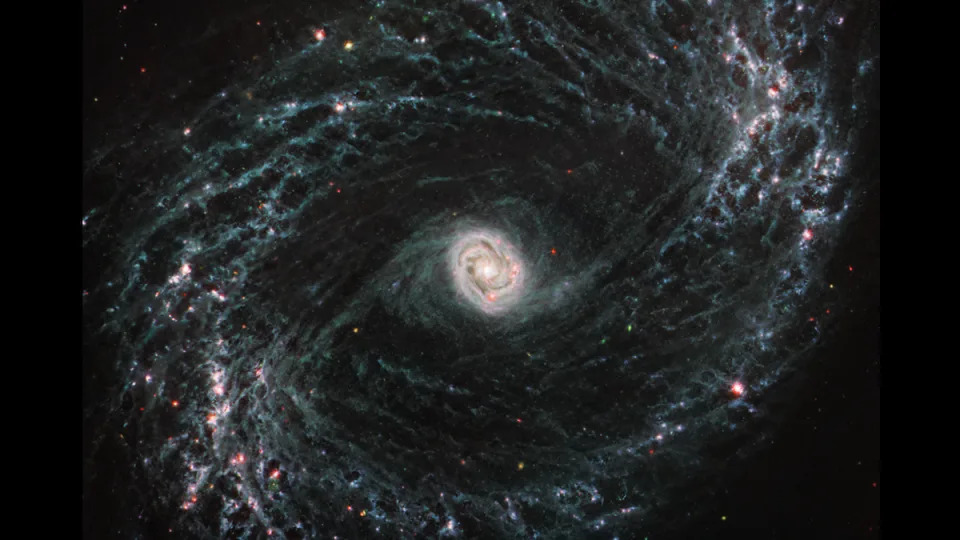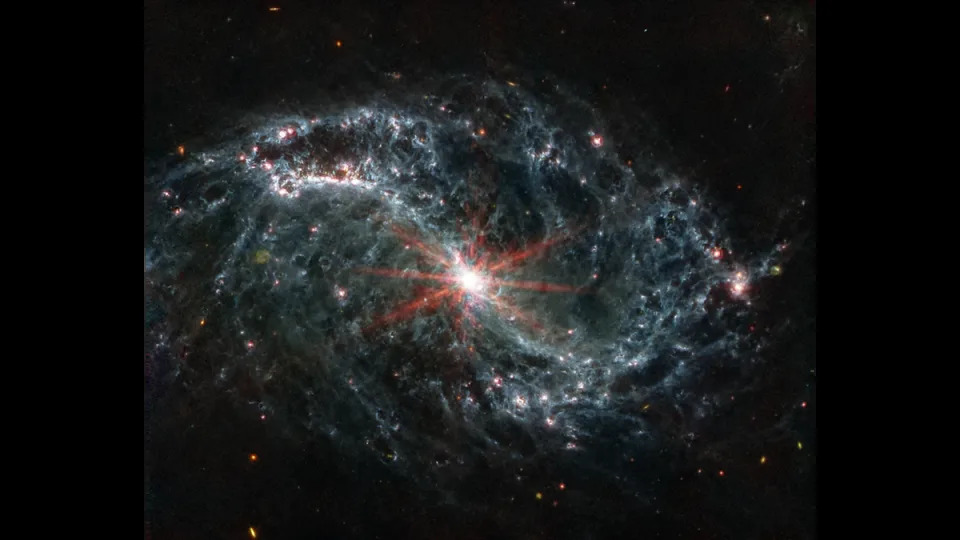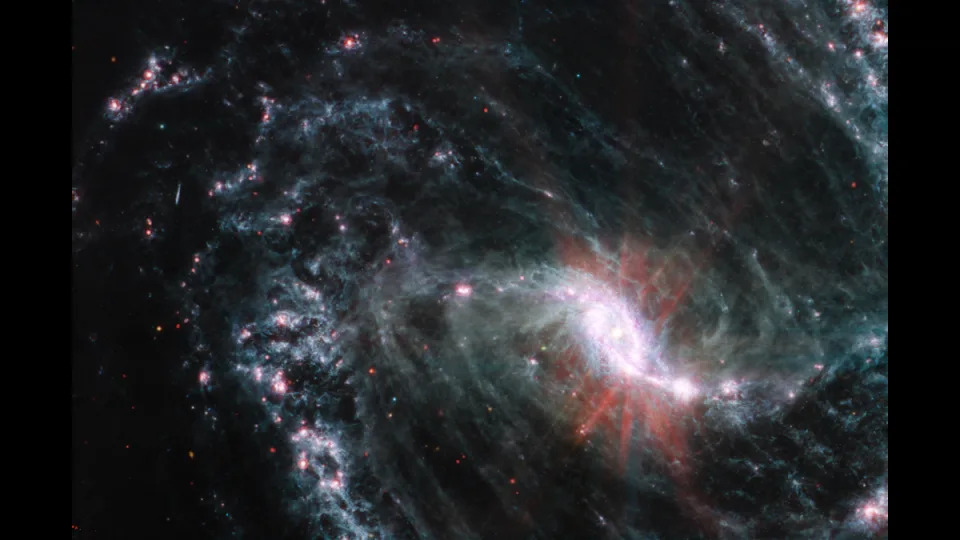Andrew Griffin
Fri, 17 February 2023

NASA, ESA, CSA, and J. Lee (NOIRLab). Image processing: A. Pagan (STScI) (NASA, ESA, CSA, and J. Lee (NOIRLab). Image processing: A. Pagan (STScI))
Nasa’s James Webb Space Telescope has given astronomers an unprecedented look at the beginnings of stars and galaxies.
New images show the intricate structure of vast, nearby galaxies. As well as being yet another spectacular image from the space telescope, it could help scientists understand how new stars form and how they affect the galaxies they are born into.
The new images are the first look at those processes in nearby galaxies at infrared wavelengths in this kind of detail.

The spiral arms of NGC 7496 are filled with cavernous bubbles and shells overlapping one another in this image from MIRI (NASA, ESA, CSA, and J. Lee (NOIRLab). Image processing: A. Pagan (STScI))
Scientists have already used the new data for 21 research papers that shed light on our universe’s processes from the very small to the very large, covering everything from the beginnings of stars to sweeping galaxies.
The work is being conducted by the Physics at High Angular resolution in Nearby Galaxies (PHANGS) collaboration, which includes over 100 researchers from across the world. They are using Webb as part of a huge survey of 19 nearby galaxies.
So far, astronomers have been able to observe five of those targets: galaxies known as M74, NGC 7496, IC 5332, NGC 1365, and NGC 1433.
“The clarity with which we are seeing the fine structure certainly caught us by surprise,” said team member David Thilker of Johns Hopkins University in Baltimore, Maryland.
“We are directly seeing how the energy from the formation of young stars affects the gas around them, and it’s just remarkable,” said team member Erik Rosolowsky of the University of Alberta, Canada.
The fine detail of the James Webb Space Telescope means that areas that were previously dark have now been lit up, and scientists can study regions that were once invisible. Researchers are now able to look at how dust between stars has absorbed light and sent it back out in infrared, which lights up the networks of swirling gas and dust.

The spiral arms of NGC 7496 are filled with cavernous bubbles and shells overlapping one another in this image from MIRI (NASA, ESA, CSA, and J. Lee (NOIRLab). Image processing: A. Pagan (STScI))
“Thanks to the telescope’s resolution, for the first time we can conduct a complete census of star formation, and take inventories of the interstellar medium bubble structures in nearby galaxies beyond the Local Group,” said Janice Lee, Gemini Observatory chief scientist at the National Science Foundation’s NOIRLab and affiliate astronomer at the University of Arizona in Tucson, who is leading the work.
“That census will help us understand how star formation and its feedback imprint themselves on the interstellar medium, then give rise to the next generation of stars, or how it actually impedes the next generation of stars from being formed.”
NASA’s James Webb Telescope uncovers new details in Pandora’s Cluster

This deep field image from NASA’s James Webb Space Telescope features never-before-seen details in a region of space known as Pandora’s Cluster. A team of researchers, including astronomers from Penn State, gathered and analyzed the data, which resulted in one of the deepest images of the early universe from Webb’s first cycle of observations.
Credit: Science: NASA, ESA, CSA, Ivo Labbe (Swinburne), Rachel Bezanson (University of Pittsburgh) Image Processing: Alyssa Pagan (STScI).
UNIVERSITY PARK, Pa. — The latest deep field image from NASA’s James Webb Space Telescope—gathered from several snapshots that were combined and analyzed by an international team including astronomers from Penn State— features never-before-seen details in a region of space known as Pandora’s Cluster, or Abell 2744.
“Previously, astronomers used NASA’s Hubble Space Telescope to study the central core of the cluster, but Webb’s powerful infrared instruments provides us with a much more detailed view of the entire area,” said Joel Leja, assistant professor of astronomy and astrophysics at Penn State a member of the UNCOVER (Ultradeep NIRSpec and NIRCam ObserVations before the Epoch of Reionization) program studying the region. “By taking advantage of a natural magnification effect called gravitational lensing, we can see a magnified view of the galaxies and other objects behind the massive galaxy cluster and can ultimately piece together an impressive image of the very distant universe.”
Webb’s view displays three clusters of massive galaxies coming together to form a megacluster. The combined mass of the galaxy clusters creates a powerful gravitational lens, warping the space around it and focusing and magnifying light that passes by. This allows much more distant galaxies — whose light is only just now reaching Earth after billions of years and reflects the early universe — to be observed by using the cluster like a magnifying glass. The result is one of the deepest images of the early universe from Webb’s first cycle of observations.
“The ancient myth of Pandora is about human curiosity and discoveries that delineate the past from the future, which I think is a fitting connection to the new realms of the universe Webb is opening up, including this deep-field image of Pandora’s Cluster,” said Rachel Bezanson of the University of Pittsburgh and co-principal investigator of the UNCOVER program. “When the images of Pandora’s Cluster first came in from Webb, we were honestly a little star struck. There was so much detail in the foreground cluster and so many distant lensed galaxies, I found myself getting lost in the image. Webb exceeded our expectations.”
The new view of Pandora’s Cluster stitches four Webb snapshots together into one panoramic image, displaying roughly 50,000 sources of near-infrared light. The UNCOVER team used Webb’s Near-Infrared Camera (NIRCam) to capture the cluster with exposures lasting 4-6 hours, for a total of about 30 hours of observing time.
"This incredible view of the cluster is just marking the beginning of an exciting journey,” said Bingjie Wang, postdoctoral researcher at Penn State and a member of the UNCOVER team. “We used modeling techniques to infer the physical properties of every galaxy captured in these images. For the first time, we are able to reveal the intricate processes governing galaxy formation and evolution from the current universe to the cosmic dawn, during which the first stars and the first galaxies formed."
This video tours Pandora’s Cluster (Abell 2744), a region where multiple clusters of galaxies are in the process of merging to form a megacluster. Astronomers estimate 50,000 sources of near-infrared light are represented in this image from NASA’s James Webb Space Telescope.
UNIVERSITY PARK, Pa. — The latest deep field image from NASA’s James Webb Space Telescope—gathered from several snapshots that were combined and analyzed by an international team including astronomers from Penn State— features never-before-seen details in a region of space known as Pandora’s Cluster, or Abell 2744.
“Previously, astronomers used NASA’s Hubble Space Telescope to study the central core of the cluster, but Webb’s powerful infrared instruments provides us with a much more detailed view of the entire area,” said Joel Leja, assistant professor of astronomy and astrophysics at Penn State a member of the UNCOVER (Ultradeep NIRSpec and NIRCam ObserVations before the Epoch of Reionization) program studying the region. “By taking advantage of a natural magnification effect called gravitational lensing, we can see a magnified view of the galaxies and other objects behind the massive galaxy cluster and can ultimately piece together an impressive image of the very distant universe.”
Webb’s view displays three clusters of massive galaxies coming together to form a megacluster. The combined mass of the galaxy clusters creates a powerful gravitational lens, warping the space around it and focusing and magnifying light that passes by. This allows much more distant galaxies — whose light is only just now reaching Earth after billions of years and reflects the early universe — to be observed by using the cluster like a magnifying glass. The result is one of the deepest images of the early universe from Webb’s first cycle of observations.
“The ancient myth of Pandora is about human curiosity and discoveries that delineate the past from the future, which I think is a fitting connection to the new realms of the universe Webb is opening up, including this deep-field image of Pandora’s Cluster,” said Rachel Bezanson of the University of Pittsburgh and co-principal investigator of the UNCOVER program. “When the images of Pandora’s Cluster first came in from Webb, we were honestly a little star struck. There was so much detail in the foreground cluster and so many distant lensed galaxies, I found myself getting lost in the image. Webb exceeded our expectations.”
The new view of Pandora’s Cluster stitches four Webb snapshots together into one panoramic image, displaying roughly 50,000 sources of near-infrared light. The UNCOVER team used Webb’s Near-Infrared Camera (NIRCam) to capture the cluster with exposures lasting 4-6 hours, for a total of about 30 hours of observing time.
"This incredible view of the cluster is just marking the beginning of an exciting journey,” said Bingjie Wang, postdoctoral researcher at Penn State and a member of the UNCOVER team. “We used modeling techniques to infer the physical properties of every galaxy captured in these images. For the first time, we are able to reveal the intricate processes governing galaxy formation and evolution from the current universe to the cosmic dawn, during which the first stars and the first galaxies formed."
This video tours Pandora’s Cluster (Abell 2744), a region where multiple clusters of galaxies are in the process of merging to form a megacluster. Astronomers estimate 50,000 sources of near-infrared light are represented in this image from NASA’s James Webb Space Telescope.
Credit: Video: STScI, Danielle Kirshenblat. Music: PremiumBeat Music, Klaus Hergersheimer. Science: Ivo Labbe (Swinburne), Rachel Bezanson (University of Pittsburgh). Image Processing: STScI, Alyssa Pagan.
In addition to magnification, gravitational lensing distorts the appearance of distant galaxies, so they look very different than those in the foreground. The galaxy cluster “lens” is so massive that it warps the fabric of space itself, enough for light from distant galaxies that passes through that warped space to also take on a warped appearance.
By taking advantage of the gravitational lensing effect, Webb revealed hundreds of distant galaxies that appear like faint arced lines in the lower right of the image. Zooming in on the region reveals more and more of them.
“Pandora’s Cluster, as imaged by Webb, shows us a stronger, wider, deeper, better lens than we have ever seen before,” said Ivo Labbe of the Swinburne University of Technology in Melbourne, Australia, and co-principal investigator on the UNCOVER program. “My first reaction to the image was that it was so beautiful, it looked like a galaxy formation simulation. We had to remind ourselves that this was real data, and we are working in a new era of astronomy now.”
The next step is to meticulously go through the imaging data and select galaxies for follow-up observation with the Near-Infrared Spectrograph (NIRSpec), which will provide precise distance measurements, along with other detailed information about the lensed galaxies’ compositions, providing new insights into the early era of galaxy assembly and evolution. The UNCOVER team expects to make these NIRSpec observations in the summer of 2023.
"These data probe deeper into the universe than we ever have before,” said Leja. “There's a lot we hope to find in the Webb data, like the first stars and the first galaxies. But often when we do tremendous things in science that no one has ever done before, it's not the things that we expect to find which are most exciting, but instead the things we never even thought to imagine. That is the Webb science I'm most excited about — the discoveries we don't even have the capacity to imagine right now.”
In the meantime, all of the NIRCam photometric data has been publicly released so that other astronomers can become familiar with it and plan their own scientific studies with Webb’s rich datasets.
“We are committed to helping the astronomy community make the best use of the fantastic resource we have in Webb,” said UNCOVER member Gabriel Brammer of the Niels Bohr Institute’s Cosmic Dawn Center at the University of Copenhagen. “This is just the beginning of all the amazing Webb science to come.”
The imaging mosaics and catalog of sources on Pandora’s Cluster (Abell 2744) provided by the UNCOVER team combine publicly available Hubble data with Webb photometry from three early observation programs: JWST-GO-2561, JWST-DD-ERS-1324 and JWST-DD-2756.
The James Webb Space Telescope is the world's premier space science observatory. Webb will solve mysteries in our solar system, look beyond to distant worlds around other stars, and probe the mysterious structures and origins of our universe and our place in it. Webb is an international program led by NASA with its partners, ESA (European Space Agency) and the Canadian Space Agency.
By taking advantage of the gravitational lensing effect, Webb revealed hundreds of distant galaxies that appear like faint arced lines in the lower right of the image. Zooming in on the region reveals more and more of them.
“Pandora’s Cluster, as imaged by Webb, shows us a stronger, wider, deeper, better lens than we have ever seen before,” said Ivo Labbe of the Swinburne University of Technology in Melbourne, Australia, and co-principal investigator on the UNCOVER program. “My first reaction to the image was that it was so beautiful, it looked like a galaxy formation simulation. We had to remind ourselves that this was real data, and we are working in a new era of astronomy now.”
The next step is to meticulously go through the imaging data and select galaxies for follow-up observation with the Near-Infrared Spectrograph (NIRSpec), which will provide precise distance measurements, along with other detailed information about the lensed galaxies’ compositions, providing new insights into the early era of galaxy assembly and evolution. The UNCOVER team expects to make these NIRSpec observations in the summer of 2023.
"These data probe deeper into the universe than we ever have before,” said Leja. “There's a lot we hope to find in the Webb data, like the first stars and the first galaxies. But often when we do tremendous things in science that no one has ever done before, it's not the things that we expect to find which are most exciting, but instead the things we never even thought to imagine. That is the Webb science I'm most excited about — the discoveries we don't even have the capacity to imagine right now.”
In the meantime, all of the NIRCam photometric data has been publicly released so that other astronomers can become familiar with it and plan their own scientific studies with Webb’s rich datasets.
“We are committed to helping the astronomy community make the best use of the fantastic resource we have in Webb,” said UNCOVER member Gabriel Brammer of the Niels Bohr Institute’s Cosmic Dawn Center at the University of Copenhagen. “This is just the beginning of all the amazing Webb science to come.”
The imaging mosaics and catalog of sources on Pandora’s Cluster (Abell 2744) provided by the UNCOVER team combine publicly available Hubble data with Webb photometry from three early observation programs: JWST-GO-2561, JWST-DD-ERS-1324 and JWST-DD-2756.
The James Webb Space Telescope is the world's premier space science observatory. Webb will solve mysteries in our solar system, look beyond to distant worlds around other stars, and probe the mysterious structures and origins of our universe and our place in it. Webb is an international program led by NASA with its partners, ESA (European Space Agency) and the Canadian Space Agency.
LAST UPDATED FEBRUARY 15, 2023
No comments:
Post a Comment